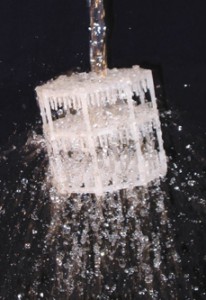The Problem
The city of Pittsfield, Massachusetts purchased two acid scrubbing towers for their Municipal incinerator. The scrubbers had to perform at unusually high particulate loadings, forcing change-out of packing every 3-4 months. Because the plant cannot operate without the scrubbers and because a plant shutdown is scheduled once a year, it was imperative to find a packing or system that could resist plugging for at least 12 months.
Why Q-PAC® was Used
Q-PAC® was selected because of its large void fraction and widely spaced grid-and-needle design, which promised reduced fouling and a much lower pressure drop. The better fouling characteristics were necessary to reduce high maintenance costs and the low pressure drop was essential to reduce operating costs.
A comparison done between Q-PAC® and 2K Tellerettes projected substantial savings in electrical power usage. Based on an average of $0.132 per KWH, an operating year of 8,000 hours, and a motor efficiency of 80%, the savings in electric power would be $986/BHP-year– an annual savings of $8,362.
Finally, Q-PAC’s performance had been substantiated by numerous studies and real- world applications, and was guaranteed by LANTEC with a 100% performance warranty.
In April 1998 the towers packed with Tellerettes showed pressure drops in excess of 4.0″ WC, indicating plugging. Kevin Rousseau of EAC decided to take a general plant shutdown as an opportunity to replace the old packing with Q-PAC®.

Meeting the Requirements
The next scheduled shutdown was in July 1999. By that time, Q-PAC® had been in service for 15 months, yet the packing showed no sign of being plugged. So EAC decided not to change it out, but to leave the Q-PAC® in the scrubbers for a second consecutive year.
In a process with heavy particulate loading, the patented plugging-resistant design of Q-PAC® made it possible to operate scrubbers 5-8 times longer between packing change-outs (1-2 years vs. 3-4 months).
Comparing the fan power usage of Q-PAC®with the original packing, Q-PAC® gave a savings in electric power costs of more than $8,000 per year!